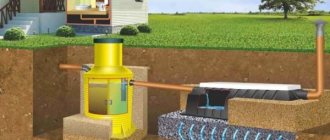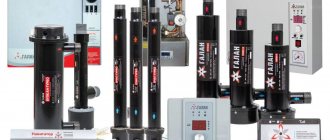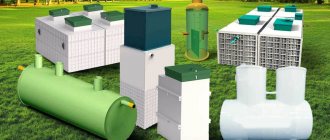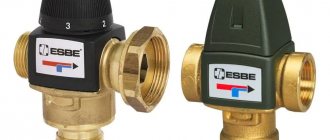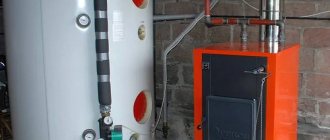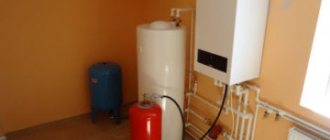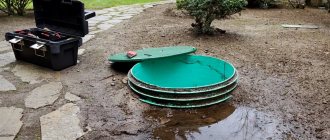To treat wastewater for your home, a special device is used - a septic tank. There are many varieties of this device on the market, which differ in design. In our article we will learn how a septic tank for a private home works, what its design principle is and how to choose it correctly.
The principle of operation of a septic tank for a private house
What is a septic tank?
A septic tank is an autonomous system for collecting, purifying, filtering and disinfecting wastewater that comes from residential and non-residential buildings. The need to install a septic device arises if the house is not connected to a central sewer system. After all, wastewater contains large amounts of microparticles of debris, dirt, and organic residues, which often harbor pathogens.
Septic tanks are usually made of metal and polymer elements connected to each other. Sewage pipes are connected to the device, and the device itself is installed in the ground at a shallow depth. Depending on the design, there are several types of septic structures, but most devices consist of the following elements:
- Drives . They take the form of cylindrical tanks of various volumes (up to 10 cubic meters), in which water is accumulated, filtered, purified and disinfected. Most modern septic tanks consist of three tanks, each of which performs different functions.
- Pipeline . Used to connect individual storage tanks to each other. Pipes are also made from metal or polymer materials. Please note that the pipes are usually installed at a slight angle - this allows for the free flow of liquid from one tank to another during cleaning.
- Wells, holes, ventilation. These elements facilitate the operation and control of septic tanks, and also perform auxiliary functions. For example, ventilation is needed to supply air inside the structure, which allows for high-quality recycling of wastewater.
Note! Some models of modern septic tanks are made in the form of a single tank, which is divided into 2 or 3 sections using walls. Such devices do not have a pipeline system, but otherwise their design is exactly the same.
Septic tank material
Most modern septic tanks are made of metal or based on polymer materials. Each variety has its own characteristics and nuances that you should know about before purchasing. Let's first consider polymer septic tanks:
- They are often equipped with stiffeners, which improves the fixation of the septic structure in the ground. The approximate service life of the products is 40-50 years if the operating rules are followed.
- Polymers come in several varieties - polyethylene, polypropylene or fiberglass. All polymer materials are easy to produce, which is why septic tanks based on them have a low price.
- Polyethylene has the lowest cost and excellent sealing properties, which is why polyethylene products are most often found on sale. However, such septic tanks have one major disadvantage - sensitivity to high temperatures (for example, hot water), which reduces the versatility of devices of this type.
- Polypropylene has approximately the same performance characteristics as polyethylene. The main difference is that it is not sensitive to high temperatures, so it can be used when working with hot water.
- Fiberglass is a relatively expensive, but more reliable and durable material. Its main feature is its resistance to chemically active substances, which will be convenient when working with polluted water bodies.
Now let’s look at metal septic tanks:
- For the manufacture of septic tanks, metal with a chrome coating is used (usually aluminum). This allows you to protect the structure from corrosion, but has a negative impact on the cost. On average, metal septic tanks are 30-40% more expensive than polymer ones of the same category.
- To protect the structure from the effects of chemically active substances and high temperatures, the septic structure inside is covered with a layer of waterproofing. For the winter, it is recommended to cover metal septic tanks with a layer of insulation on top (however, many modern designs already contain an insulation layer).
Note! Some septic tanks are made on a combined basis: some elements are made of metal, and others are made of plastic. However, the market is still dominated by products based on one of the materials.
Types of septic tank
Types of septic tanks
Above, we described the typical elements of a septic device, however, real septic tanks may have a slightly different design. The variety of septic tanks allows you to select a device for a specific engineering task, which is very convenient. There are the following main types of septic tanks:
- Single-section septic tank . As the name implies, it consists of one large reservoir (usually 4-5 cubic meters) into which groundwater flows. During settling, solid particles settle to the bottom, and purified water flows into the pipe. In the future, the water can flow into the ground or the garden irrigation system. A single-section drive is easy to use, but it has many disadvantages. The main drawback is the average quality of cleaning. In addition, the drive must be cleaned frequently, which increases costs.
- Septic tank with ground treatment system. May consist of two or three chambers (the more, the better the quality of cleaning). Here, filtration is carried out due to the action of anaerobic bacteria, as well as ground purification systems. Septic tanks in this category are distinguished by high quality cleaning, but they are quite difficult to assemble. In addition, such devices accumulate waste, so periodically the device also requires pumping out sewage.
- Septic tank with biological treatment system. Usually performed in the form of a single block, divided into three independent chamber sections. The main feature is the use of a second chamber, which contains beneficial aerobic bacteria that decompose lungs and part of the solid particles. Thanks to this, two problems are solved at once. Firstly, the quality of water purification as a whole improves, and there is no need to create a ground purification system. Secondly, most of the organic residues are completely decomposed in the septic tank into water and carbon dioxide. Therefore, a biological three-section septic tank needs to be cleaned much less frequently.
Classification
In addition to the principle of operation, septic tanks may also differ in a host of other parameters. Let's consider the main classification systems:
- In size - small (1-2 cubic meters), medium (2-5 cubic meters) and large (up to 10 cubic meters). The more sewage a house “produces,” the larger the volume of the septic tank should be. In practice, medium devices with 3-5 cubic meters are usually used. In dachas and garden plots it is possible to use small devices. Large settling tanks are suitable for technical buildings or multi-storey buildings.
- Depending on electricity - volatile and non-volatile. Devices of the first type perform water purification through the use of electrical devices. This improves the quality of cleaning, but increases energy costs. Non-volatile systems operate without electrical appliances, and filtration is carried out by gravity, mechanical cleaning systems and beneficial bacteria.
How does it work
The principle of operation depends on the design of the septic tank:
- In single-chamber settling tanks, water is stored for a certain period of time. Due to the action of gravity, heavy particles settle to the bottom. If electrical devices are connected to the appliance, they may perform additional cleaning.
- In ground treatment systems, water passes through several chambers, where it is gradually purified. In the first chamber, water settles, as well as partial decomposition of particles due to anaerobic bacteria. In the second and third chambers, cleaning occurs due to mechanical devices (drainage system, mini-trenches and others).
- In bioseptic tanks, filtration is carried out in three chambers. In the first, solid particles settle and decompose due to anaerobic bacteria. In the second, fermentation occurs, as a result of which bacteria decompose light particles of organic residues. In the third section, additional cleaning is performed due to sedimentation and anaerobic bacteria.
Classification
All septic tanks that are used today to install a sewage system can be classified according to the following criteria:
According to the working method:
- accumulative;
- with soil filtration;
- with deep cleaning.
According to the material of manufacture:
- brick;
- reinforced concrete monolithic and conventional prefabricated well rings;
- metal;
- based on polymers and fiberglass;
- from other materials.
Diagram of a septic tank made of concrete rings.
Depending on location:
- vertical;
- horizontal.
According to the location of the chambers of the cleaning tank:
- superficial, that is, located above the surface of the soil;
- underground, laid in specially prepared trenches.
By connection method to utility networks:
- volatile, that is, operating from the electrical network;
- Autonomous, not requiring electricity to operate.
Features of the operation of different types of septic tanks
Features of the operation of different types of septic tanks
Let's consider the important features of various septic devices:
- Single-section septic tank . Such devices are often equipped with electrical devices, during operation of which water is separated from light and heavy particles of debris. This allows you to increase the quality of the water received, but requires constant electricity costs, which is not very profitable. The drive can filter water without electricity, but the quality of cleaning will be mediocre.
- Septic tank with ground treatment system. Additional cleaning systems are different - it can be a gravel-sand mixture, mini filter trenches, a well-filter system, and so on. Each system has different efficiency, and assembling such a system is quite difficult. Some septic tanks in this category are equipped with electric filter devices.
- Septic tank with biological treatment system . A bioseptic tank is a very convenient, simple and high-quality device that is easy to install in the ground. The use of aerobic bacteria improves the quality of decomposition of sewage, so such a septic tank needs to be cleaned much less often. In addition, devices with a biological purification system are completely autonomous - there is no point in connecting electrical filters to them.
The principle of operation of a septic tank without pumping
A septic tank without pumping is a device with a biological treatment system. Above we have already briefly examined the principle of its operation; now let’s look at it more carefully:
- The septic tank is installed in the ground at a shallow depth. Individual elements of the septic tank have access to the open air using a system of wells and ventilation. The septic tank is connected to wastewater (to sewerage and water supply) using a pipeline.
- When formed, wastewater flows into the septic tank, entering its first chamber. Here, contaminated water settles, and under the influence of gravity, heavy particles settle to the bottom. Some of the residues are decomposed by the work of anaerobic bacteria. Light particles along with water enter the second chamber.
- In the second chamber, water is re-filtered, which can be used to get rid of light particles. Filtration in this chamber is usually accomplished by anaerobic bacteria, which break down light particles into their constituent components (usually water, carbon dioxide and particulate matter).
- Partially purified water enters the third compartment, where solid particles formed in the second stage gradually settle to the bottom. This stage is the last, and after that the purified water enters the soil or the garden irrigation system. Please note that drinking this water is not recommended, although it is suitable for technical needs.
Note! During operation of the bioseptic tank, a large amount of non-toxic gases are released. It is therefore important that the device is equipped with a ventilation system to remove these gases.
How to choose the right septic tank
Let's look at the basic rules for choosing a septic device for your land:
- If we are talking about a dacha that you visit quite rarely, then you can install a simple single-chamber sump tank with a capacity of 3-4 cubic meters. In this scenario, it will fill up slowly enough, so you won’t have to call a vacuum cleaner often. This device is cheap and easy to install.
- If you live with a small family, it makes sense to think about purchasing a device with ground-based post-treatment or a bioseptic tank. The first type of device can be installed if you have “golden hands”, since the drainage system is difficult to install. Bioseptic in this sense is much simpler and more versatile.
Attention! When choosing a drainage device and a bioseptic tank, be guided by consumption standards. According to statistics, the consumption rate for an adult is 250-300 liters of water. Information on the amount of water to be treated can be found in the instructions for the septic tank.
How to choose a septic tank for your home video
Performance
The performance of any treatment facility means its ability to effectively treat a given volume of wastewater generated during the operation of a country house. This indicator determines the number and size of chambers of the purchased structure. With limited volumes of wastewater, it is permissible to use a single-chamber pre-treatment septic tank, which is quite capable of processing a small mass of household waste.
The simplest low-capacity septic tank
To efficiently process large masses of wastewater (with a daily volume of generated waste exceeding 1 m3), you will need a septic tank model with increased productivity.
If your summer cottage is intended for seasonal family vacations, it will be possible to get by with a standard pre-treatment facility with a volume of up to 1 m3.
This simplest version of a cleaning device is usually used as a simple storage tank, periodically emptied by the owner himself, or with the help of special sewage disposal equipment.
Anyone who would like to decide on the choice of a septic tank and plans to live in their country house permanently is not advisable to choose this option. If there is a large amount of waste generated, you will have to use the services of vacuum cleaners too often, which nowadays are not at all cheap.
Selecting a construction site
When choosing a place to install a septic tank, be guided by the following GOST sanitary standards:
- The septic tank should be located a short distance from the house so that there is no need to install a long pipe. The best option is 5-10 meters. Please note that a distance of less than 5 meters is also not allowed - otherwise the device will negatively affect the strength of the foundation.
- There should not be a well with drinking water near the septic tank, since otherwise the water from the septic tank may contaminate it. The optimal distance from the septic device to the well is 50 meters (in the case of easily permeable soil - 100 meters).
- Septic tanks will need to be cleaned periodically as they will accumulate non-decomposing particles of dirt and debris. Therefore, it is necessary to locate the structure underground in such a way that a sewage truck can easily approach it.
Rules for installing autonomous sewers
Local sewerage is a system that can potentially pose a threat to the environment and ecological situation of the region. You can’t just spontaneously build a treatment facility. It is necessary to first develop project documentation, approve it with the SES authorities, obtain permission, and only after that begin purchasing materials and starting construction work. During the installation of sewerage, you should adhere to the norms and rules regulated by SNiP and SanPiN. When choosing a septic tank location on the territory, it is very important to take into account the recommended distance from the tank to various objects:
- to the house - at least 5 m;
- to artificial or natural reservoirs - at least 30 m;
- to reservoirs with running water – from 10 m;
- between sources of drinking water and sewage tanks, the distance is at least 50 m;
- to trees – 3 m, to bushes – 1 m;
- to the road – 5 m;
- to the gas pipeline running underground – 5 m.
You must strictly adhere to the installation instructions and perform technological processes carefully and carefully. The performance characteristics and service life of sewer systems depend on the quality of the container for the septic tank, as well as on how competently the installation work is performed. Typical mistakes that are made in the process of arranging a septic tank: poor sealing of joints, incorrect installation of pipes, as a result of which there is no overflow from one compartment to another.
There are enough varieties of septic tanks today. You can buy a ready-made structure and install it on the territory of your home quickly and without much effort. And you can save money by spending time on arranging an autonomous sewer system from scrap materials. What to do? The choice is yours. The main thing is that the septic tank is built in compliance with all norms and requirements, does not harm the environment, and properly performs its functions for a long period.
Advantages and disadvantages
Before the invention of septic tanks, cesspools were used to filter water. Digging such a hole was quite simple, but it provided poor cleaning quality, which negatively affected the health of the soil. The invention of septic tanks was a major breakthrough in the issue of cleaning, since these devices had many advantages.
Advantages and disadvantages
High quality cleaning, effective separation of water from debris and organic residues.
Long service life (settlement pits had to be pumped out periodically).
No unpleasant odor on the land, beneficial effect on the soil.
A relatively simple method of installation and commissioning (for some types of purchased septic tanks).
Very expensive
Septic tank for a private house
Septic devices are usually installed in suburban areas that are not connected to a central sewer system. These can be small residential buildings, dachas, low-rise cottages, and so on. Below we will look at the algorithm and installation features of this device.
How does a septic tank work for a private home?
Above we have already examined the principle of operation of septic tank devices. In private homes they will function according to identical principles. Let us briefly recall the operating principle:
- All wastewater from the house through the sewer and water supply system enters the septic device, where it is collected, settled and purified. Upon completion of filtration, the water enters either the soil or the garden irrigation system (it is not recommended to drink such water). The septic device itself is installed in the soil at a shallow depth, and the components of the system are connected to each other using pipes.
- Septic devices may have certain differences in design, which affects their operating principle. In single-chamber settling devices, water enters a large tank, where solid particles settle to the bottom. In ground-based post-treatment systems, there are additional chambers where the water undergoes additional purification using anaerobic bacteria and mechanical devices. In bioseptic tanks, filtration is carried out due to sedimentation and the work of aerobic bacteria, which decompose all organic residues into water and carbon dioxide.
How to make a septic tank in a private house
So, you bought a septic device - let's find out how to install it:
- Make a pit in the ground at least 6 meters from the house. When choosing the height of the pit, remember that a cushion of sand and gravel will be placed on its bottom.
- Compact the soil and then form a layer of sand and gravel at the bottom. Place a septic tank on top, strengthen it with metal strips or cables.
- Connect the wastewater pipe from your home to the septic system . Please note that the pipeline in the ground must be installed at an angle so that the water flows on its own.
- Bury the septic tank so that the ventilation is slightly higher above ground level. This is done to prevent the ventilation hatch from being flooded with water and covered with earth.
Note! In winter, it is recommended to insulate the septic tank so that the water inside does not freeze, which will make the cleaning structure useless.
Do-it-yourself septic tank for home without pumping video
Design elements
The main design elements are:
- Septic tank chambers (in the case of a bioseptic tank, a cast chamber).
- Pipeline for connection to the house.
- Cushion based on gravel and sand.
- In the case of a system with ground purification - gravel-sand mixture, filtering mini-trenches, well-filter system.
Features of a septic tank for a home
Let's list them:
- For a home, a volumetric bioseptic tank of 6-8 cubic meters will be sufficient. It is also possible to install a system with ground-based post-treatment, but this will require additional skills and experience.
- A single-chamber settling system will not work, since such devices have a small volume and will have to be cleaned frequently. Although if you live alone, you can bet.
- For private homes, it is recommended to take a device made of plastic. Metal structures are poorly suited for housing, although they withstand frost better.
The principle of operation of a septic tank for a private house
The principle of operation of a septic tank for a private house
We have already discussed the principle of operation above - let us recall it in a nutshell:
- For single-chamber sedimentation tanks, water is placed in a tank, heavy particles settle at the bottom, and purified water enters the soil.
- In systems with ground-based post-treatment, debris and particles are decomposed by anaerobic bacteria; additional cleaning is performed through drainage.
- In bioseptic tanks, water passes through several compartments, where it remains, and light particles decompose due to the work of aerobic bacteria.
Overflow
Overflow pipes in the ground should be inclined so that water can flow into the septic tanks under the influence of gravity. If the soil is clayey or too loose, it is recommended to install overflow pipes on a bed of gravel or sand. It is recommended to give preference to expensive plastic pipes that have good strength.
Ventilation
To remove gases from the tanks, it is recommended to connect them to a ventilation system that will vent to the open air. There should be one or two ventilation pipes, and their minimum diameter should be 10 centimeters. If you are working with a bioseptic tank, then the ventilation pipe must be present (otherwise the device will not work).
Setup
In order for bacteria to effectively decompose organic residues, it is necessary to set up a septic tank. To do this, you need to “add” beneficial bacteria to the device. You can do this in two ways:
- From another septic tank. To do this, you need to take sediment from an already operating device, which already contains all the necessary bacteria.
- With the help of bioadditives. You can buy a set of necessary bacteria at any store that sells goods for the garden or plumbing.
Construction of the above-ground part of the street toilet
After constructing the foundation for the outdoor toilet with your own hands and installing the container, you need to start building the booth. This process consists of the following steps:
- You need to lay a piece of roofing felt on the surface of the foundation.
- A wooden beam measuring 100x100 mm should be used for the bottom frame of the base under the floor. Before this, it must be treated with an antiseptic solution.
- To build a reliable foundation, install the bars around the perimeter of the structure and in the middle of the long side of the structure, attach them with nuts, after placing them on metal pins.
- Using 40 mm thick boards, build the floor of the future toilet. In this case, it is necessary to leave a hole under the toilet where the container is located.
- Attach 4 wooden columns to the corners of the base. Two of them should have a height of 2 m, and the other two should have a height of 2.2 m. Choose bars with a cross section of 100x50 mm. They need to be attached using metal corners and wooden spacers. Before final installation of the frame, check the verticality of the posts.
- On the front wall under the doors, install additional columns of the same section. The width of the opening should be 0.7 m and the height 1.97.
- Fasten the racks on the other side with a vertical jumper at a level of 1.77 m, which will also serve as the base for the roof.
- Along the structure, leaning on the installed jumpers, attach two rafter legs.
- As roof sheathing, use 40 mm thick boards, which must be attached to the rafters using regular nails.
- Using screws, install an OSB sheet to the lattice covering, which will act as a base for the roofing material.
- Use soft bitumen shingles or roofing felt as a covering. It is necessary to choose materials that will not create additional load on the structure.
- For wall cladding, use a tongue-and-groove or half-tongue board 2-4 cm thick.
- To prevent the inside of the building from being hot in summer and cold in winter, you need to make thermal insulation with your own hands. To do this, install foam sheets in the inner plane of the frame. After this, you need to additionally sew up the walls with another layer of board.
- Apply a special impregnation to all wooden elements, which will protect their surface from the harmful effects of moisture and other negative environmental factors. You can also additionally use fire retardants.
- Install doors on the curtains. You can equip them with a small window to illuminate the interior space during the daytime.
What is better - self-production or a ready-made design?
It all depends on two parameters - your income level and experience in working with plumbing equipment:
- If you have a good income and no experience working with plumbing, then it is better to buy a ready-made septic tank. The fact is that self-assembly is quite complicated, and during installation you can make many mistakes. Because of this, the resulting septic tank will be of poor quality and will quickly fail.
- If you don’t have enough money, and you work well with your own hands, then you can assemble the septic tank yourself. Statistics show that the level of savings will be on average 30-50% (that is, 1.5-2 times less money will be spent on spare parts than on the purchase of a finished structure).
- If you are good with technical skills, but also have a lot of money, then it depends on your priorities. You can either assemble it yourself or buy it ready-made. If you install it yourself, you will save money, but you will lose time. Are you ready to make such sacrifices? Think for yourself.
Note! The average cost of a modern bioseptic tank ranges from 40 to 80 thousand rubles. There are both more expensive and cheaper devices on sale.
Recommendations
Keep an eye on what waste ends up in your drains. Cotton wool, foil, hair, and thick paper practically do not dissolve in the septic tank, so you will have to pump out the device frequently. In winter, it is recommended to cover the device with insulation to avoid water freezing. Installation is recommended to be carried out in the warm season (that is, at above-zero air temperatures). If you have just moved to the site, but do not have the energy or money for a septic tank, you can dig a slop pit for the first time. However, it is not recommended to use it for a long time, since it will poison the soil with waste.
From polymer to metal
All septic tanks can be made from different materials; many options can be found on the market. In addition to plastic and metal ones offered by manufacturers, there are options for brick septic tanks and even containers made from old tires. They all differ in their characteristics.
Inexpensive but very durable septic tank barrels, which are used in the construction of a sewer system, have become very popular. Such containers are light in weight and very durable. Often fiberglass septic tanks have special stiffening ribs that can withstand even high pressure.
Septic tank operation diagram.
But there are also disadvantages, including such an important factor as light weight. Barrels are easily pushed to the surface, so it is necessary to create a concrete slab in the pit as a base to which the septic tank will be attached with a chain. This will avoid pushing out and ensure strength and reliability. It is recommended to concrete the pit itself so that the soil does not exert excessive pressure; it is recommended to fill the space between the walls with gravel and lay insulation. When choosing plastic barrels, preference should be given to those that have stiffeners.
Efficiency of masonry
For small summer cottages, brick cesspools are popular. How to use them? Such a septic tank is a pit in the ground, which is lined with bricks from the inside. After masonry, the walls are rubbed with cement mortar, a cover is constructed from a wooden panel on the outside, and ventilation is removed.
Septic tank with brick walls.
Among the advantages, it should be noted that the installation of such a septic tank is extremely simple, as is its use. It is only necessary to regularly clean it of the waste that accumulates in it. But there are also disadvantages: the ventilation goes directly outside the ground, that is, a rather unpleasant odor can be observed in the area, which is difficult to get rid of. If the dacha is used only for growing garden crops, then this does not matter much. But if there is a house on the site for year-round use, you need to choose another option.
Reinforced concrete buildings
Reinforced concrete septic tanks can have a variety of interpretations:
- monolithic, for their installation a pit is dug, after which formwork, a reinforced belt are installed, and a concrete mixture is poured;
- prefabricated reinforced concrete for the construction of a sewer well.
Both options are quite durable and reliable, they are easy to use
When building a septic tank from rings, great attention must be paid to sealing the joints using a special sealant and tow. In this case, the wastewater simply will not be able to penetrate the soil and infect it.
Septic tank made of reinforced concrete.
Metal tanks as septic tanks have been used less and less in recent years, as they are highly susceptible to corrosion, the walls can quickly become leaky, which means that untreated wastewater will end up in the ground. Large metal barrels and old tanks are used as containers, in which holes are made for the flow of wastewater. Such barrels can be sunk into the ground or placed in the open air without special supports. Nowadays, experts recommend abandoning them, since their cost is high and their use is not so effective.
Available materials
Quite often, homemade septic tanks are installed in dachas. Experts do not recommend installing them yourself if you do not have the necessary experience, but you can still often see brick containers or septic tanks from an old metal barrel, which are buried in the ground or placed on special supports above ground level.
One of the most unusual homemade septic tanks is a container made from rubber tires. Although it is convenient, there are a number of significant disadvantages. The barrels do not have a bottom, their walls are not airtight, that is, during use, contamination of the soil is possible. Therefore, they should be used carefully, only if the volume of waste is small.
Tips for use
To increase the shelf life of the structure, remember these additional recommendations:
- When installing, be sure to install a ventilation pipe. This will increase the efficiency of the septic device, which will have a beneficial effect on the quality of cleaning.
- In the first chamber you can buy a set of special anaerobic bacteria that will decompose organic residues. This will also have a beneficial effect on the quality of cleaning.
- If you are young and have a family, then it is recommended to take a septic tank with a small reserve (20-30%). After all, it is quite possible that you will want to have children, which will increase water production.
- It is recommended to pump out the septic tank in advance (that is, you do not need to wait until the garbage reaches the limit specified in the instructions). This will increase the shelf life of the device.
Types of concrete rings
The rings differ in the type of construction:
The final structural element of a reinforced concrete septic tank
- With a bottom. A monolithic product, which is installed first in the pit, with wall walls on top. Used to create a sealed container, leaks do not occur during the entire period of operation. Standard height is 0.9 m.
- Castle ones. With special recesses in the upper and lower parts. During installation, a reliable connection occurs. Indispensable for the construction of septic tanks on floating soils.
- With lid. There is a hole in the ceiling for a hatch. This is the final element of the well. The monolithic product increases the strength of the entire structure.

